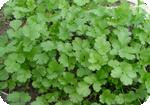Coriander (Coriandrum sativum), also known as
cilantro, Chinese
parsley or dhania, is an annual herb in the family Apiaceae.
Coriander is native to regions spanning from southern Europe and North Africa to southwestern Asia.
Zaidi SF, Muhammad JS, Shahryar S, Usmanghani K, Gilani AH, Jafri W, Sugiyama T.
Anti-inflammatory and cytoprotective effects of selected Pakistani medicinal plants in Helicobacter pylori-infected gastric epithelial cells. 1. J Ethnopharmacol. 2012 May 7;141(1):403-10. Epub 2012 Mar 13.  ETHNOPHARMACOLOGICAL RELEVANCE: Helicobacter pylori infection is associated with gastritis, peptic ulcer, and gastric cancer. Due to its high global prevalence and uprising resistance to available antibiotics, efforts are now directed to identify alternative source to treat and prevent associated disorders. In the present study, effect of selected indigenous medicinal plants of Pakistan was evaluated on the secretion of interleukin-8 (IL-8) and generation of reactive oxygen species (ROS) in a bid to rationalize their medicinal use and to examine the anti-inflammatory and cytoprotective effects in gastric epithelial cells. MATERIALS AND METHODS: AGS cells and clinically isolated Helicobacter pylori strain (193C) were employed for co-culture experiments. Anti-Helicobacter pylori activity and cytotoxic effects of the selected plants were determined by serial dilution method and DNA fragmentation assay respectively. ELISA and flow cytometry were performed to evaluate the effect on IL-8 secretion and ROS generation in Helicobacter pylori-infected cells. RESULTS: At 100?g/ml, extracts of Alpinia galangal, Cinnamomum cassia, Cinnamomum tamala, Mentha arvensis, Myrtus communis, Oligochaeta ramose, Polygonum bistorta, Rosa damascena, Ruta graveolens, Syzygium aromaticum, Tamarix dioica, and Terminalia chebula exhibited strong inhibitory activity against IL-8 secretion. Of these, four extracts of Cinnamomum cassia, Myrtus communis, Syzygium aromaticum, and Terminalia chebula markedly inhibited IL-8 secretion at both 50 and 100?g/ml. Cinnamomum cassia was further assessed at different concentrations against Helicobacter pylori and TNF-? stimulated IL-8 secretion, which displayed significant suppression of IL-8 in a concentration-dependent-manner. Among the plants examined against ROS generation, Achillea millefolium, Berberis aristata, Coriandrum sativum, Foeniculum vulgare, Matricaria chamomilla and Prunus domestica demonstrated significant suppression of ROS from Helicobacter pylori-infected cells (p<0.01). CONCLUSION: Results of the study revealed anti-inflammatory and cytoprotective effects of selected medicinal plants which could partially validate the traditional use of these plants in GI disorders particularly associated with Helicobacter pylori. Furthermore, results obtained may lead to possible future candidates of chemoprevention against peptic ulcer or gastric cancer.
ETHNOPHARMACOLOGICAL RELEVANCE: Helicobacter pylori infection is associated with gastritis, peptic ulcer, and gastric cancer. Due to its high global prevalence and uprising resistance to available antibiotics, efforts are now directed to identify alternative source to treat and prevent associated disorders. In the present study, effect of selected indigenous medicinal plants of Pakistan was evaluated on the secretion of interleukin-8 (IL-8) and generation of reactive oxygen species (ROS) in a bid to rationalize their medicinal use and to examine the anti-inflammatory and cytoprotective effects in gastric epithelial cells. MATERIALS AND METHODS: AGS cells and clinically isolated Helicobacter pylori strain (193C) were employed for co-culture experiments. Anti-Helicobacter pylori activity and cytotoxic effects of the selected plants were determined by serial dilution method and DNA fragmentation assay respectively. ELISA and flow cytometry were performed to evaluate the effect on IL-8 secretion and ROS generation in Helicobacter pylori-infected cells. RESULTS: At 100?g/ml, extracts of Alpinia galangal, Cinnamomum cassia, Cinnamomum tamala, Mentha arvensis, Myrtus communis, Oligochaeta ramose, Polygonum bistorta, Rosa damascena, Ruta graveolens, Syzygium aromaticum, Tamarix dioica, and Terminalia chebula exhibited strong inhibitory activity against IL-8 secretion. Of these, four extracts of Cinnamomum cassia, Myrtus communis, Syzygium aromaticum, and Terminalia chebula markedly inhibited IL-8 secretion at both 50 and 100?g/ml. Cinnamomum cassia was further assessed at different concentrations against Helicobacter pylori and TNF-? stimulated IL-8 secretion, which displayed significant suppression of IL-8 in a concentration-dependent-manner. Among the plants examined against ROS generation, Achillea millefolium, Berberis aristata, Coriandrum sativum, Foeniculum vulgare, Matricaria chamomilla and Prunus domestica demonstrated significant suppression of ROS from Helicobacter pylori-infected cells (p<0.01). CONCLUSION: Results of the study revealed anti-inflammatory and cytoprotective effects of selected medicinal plants which could partially validate the traditional use of these plants in GI disorders particularly associated with Helicobacter pylori. Furthermore, results obtained may lead to possible future candidates of chemoprevention against peptic ulcer or gastric cancer.



 ETHNOPHARMACOLOGICAL RELEVANCE: Helicobacter pylori
ETHNOPHARMACOLOGICAL RELEVANCE: Helicobacter pylori 






